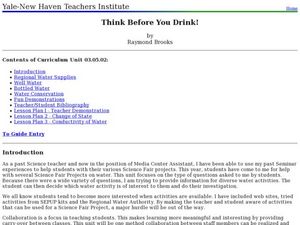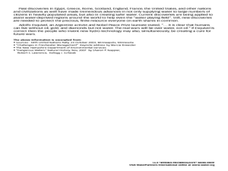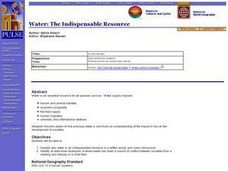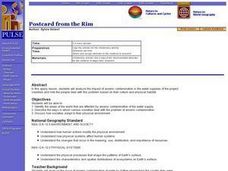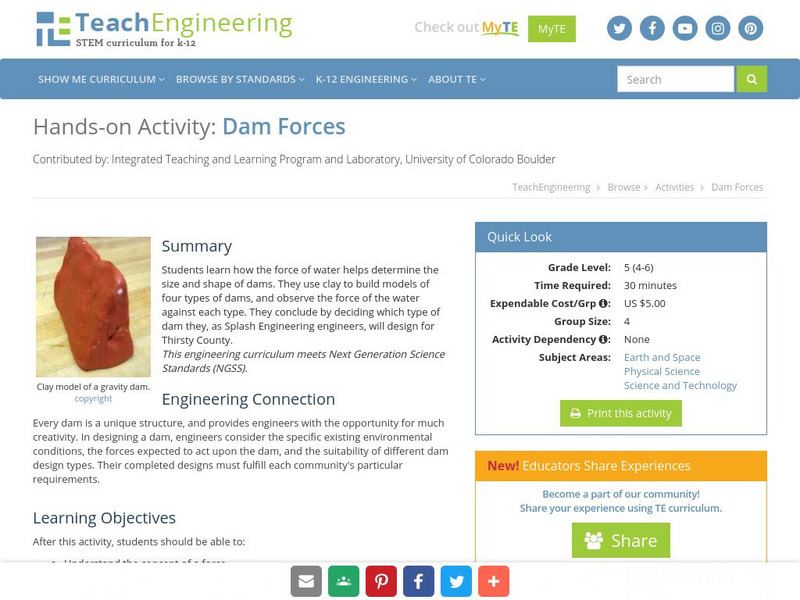Environmental Protection Agency (EPA)
Excuse Me, Is This the Way to the Drainpipe?
Elementary kids read and color the story of Willy Wetsworth, a drop of water, as he describes the journey that he and his friends take to provide fresh water to houses. He tells his story to Martha Merriweather, a little girl, and...
Pulitzer Center
Exploring Downstream: Water Resources
The lack of clean water is a life-threatening plight for millions of people around the world. Through an extensive WebQuest, young environment or social studies classes compare our water availability to that of the cxitizens of Ethiopia,...
Curated OER
Land Plan Challenge
Links to two different versions of this mapping activity are available. In "The Small Version," youngsters design a town, keeping the water supply in mind. In "The Large Version," they also design a town, but they consider services and...
Curated OER
The Global Precipitation Measurement Mission (GPM) Lesson
Introduce your class to one of the ways that technology is benefiting humanity. The Global Precipitation Measurement Mission involves the data collected by nine satellites from different countries with a united focus on studying world...
Curated OER
Watering Our Prairie Farms
After reading an article about irrigation on Canadian farms, learners participate in a discussion. They individually write an opinion paper about the surrounding issues. A lesson like this can be used in an earth science class when...
Curated OER
Think Before You Drink
Students explore the different water issues facing society today. In this environmental science lesson plan, students research about water treatment methods. They brainstorm ways to conserve water.
Curated OER
Water -- Here, There and Everywhere
Students compare quantities of water. In this water lesson students examine the hydrologic cycle looking for the amount of fresh water that is available. Students use information from charts and diagrams.
Curated OER
Hydro-Technology
Young scholars create a design for water collection, sanitation, or supply. In this hydro-technology lesson, students learn about the global water crisis. Groups of young scholars read water technology articles, draw or design a device...
Curated OER
How Much Water?
Students investigate amount of water available in different countries around the world, compare it to their daily water use, and explore how unequal distribution of water can cause challenges to survival. Students then discuss need to...
Curated OER
Water Everywhere: Is There Enough to Drink?
Students examine water supply issues caused by population growth and land use. They read and discuss an article, develop a water usage trivia game, write a news article, illustrate a desalination process, and research aquifer systems.
Curated OER
Why Do We Build Dams?
Students are introduced to a dam and what a dam does. In this dam lesson plan, students explore how a dam uses water supply, electricity generation, flood control, recreation, and irrigation in order to control the water.
Curated OER
Domestic Water Supply Case Study
Young scholars follow the cycle of a raindrop from its source into the water supply for their houses and then back to the environment. They draw and, properly label and explain a diagram of a water treatment plant and a sewage treatment...
Curated OER
Water-Is There Going to be Enough?
Learners research the availability, usage and demand for water in the local area historically and use projections of the availability, usage and demand for water up to the year 2050. They gather data and present the information in...
Curated OER
A Town in Trouble
Students identify and describe the parameters and analytical techniques used to characterize water contamination in a class presentation. They identify the consequences of high contamination levels in the water supply during a class...
Curated OER
World Geography: Water: The Indispensable Resource
High schoolers are able to explain why water is an indispensable resource in a written essay and class discussion. They identify at least three examples of where water has been a source of conflict between societies from a reading and...
Curated OER
World Geography: Postcard from the Rim
Young scholars are able to identify the areas of the world that are affected by arsenic contamination of the water supply. They are able to describe the ways in which various societies deal with the problem of arsenic contamination. ...
Columbia University
Nasa: Sedac: Water Resources and Consumption
[Free Registration/Login Required] A collection of twenty-four data sets from SEDAC (Socioeconomic Data and Applications Center) that examine water resources and issues around the world. They look at dams and reservoirs, floods, drought,...
Idaho State University
Idaho State University: Surface Water Process, Supply and Use
This environmental geology resource identifies the significance of our land's surface water. Review the sources of water and how they are processed and used.
BioEd Online
Bio Ed Online: Can Nutrients in Water Cause Harm?
Many different kinds of organisms live in water. Excess nutrients can cause over-abundant growth of some organisms living in water and non-point source pollution is a major threat to water supplies in the United States. In this lesson...
PBS
Pbs Learning Media: Construct an Aqueduct
Think like an engineer and build an aqueduct in this interactive activity from the NOVA: "Secrets of Lost Empires: Roman Bath" Web site.
Other
Canadian Water Network
This organization is funded by the Canadian government. Its mandate is to study water issues and come up with strategies for the effective management of Canada's water resources to preserve them for present and future generations. There...
Other
British Columbia Water and Waste Association
Non-profit organization that educates and trains people to safeguard public health and the environment. Water and wastewater industries are important parts of an environmental plan that ensures the future use of Canada's water supply.
TeachEngineering
Teach Engineering: How Much Water Do You Use?
Students keep track of their own water usage for one week, gaining an understanding of how much water is used for various everyday activities. They relate their own water usages to the average residents of imaginary Thirsty County, and...
TeachEngineering
Teach Engineering: Dam Forces
Students learn how the force of water helps determine the size and shape of dams. They use clay to build models of four types of dams, and observe the force of the water against each type. They conclude by deciding which type of dam...







